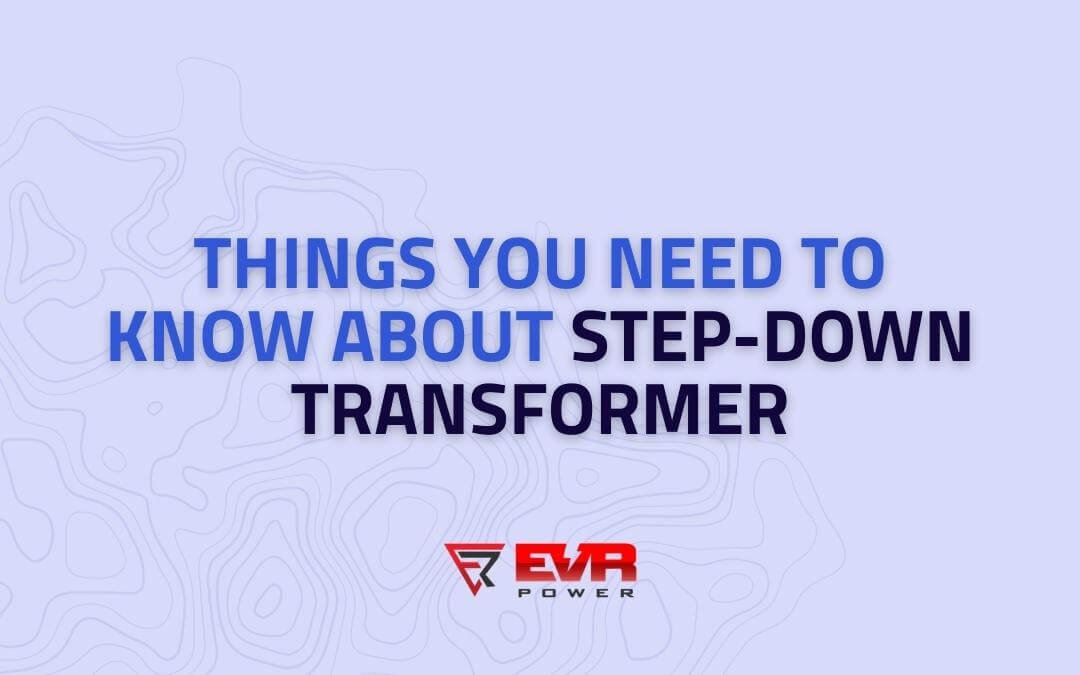Modern-day electronics is largely dependent on the application of a Step-Down Transformer to cater to the needs of operating electrical appliances. A Step-Down Transformer reduces high voltage to low voltage and hence it plays a vital role in operating electrical appliances in our households and industries. Let us try to understand the concept of a step-down transformer, the working principle, advantages, and disadvantages in this blog post.
Also Read:- Top Transformer Manufacturers in India
What is a step-down transformer?
As the name suggests it is used to bring down the voltage from the primary winding to the secondary winding i. e. it converts a high voltage to the low current alternating source to a low voltage and high current alternating supply. It is a static device that transmits electrical power from one circuit to another.
How does the transformer step down the current?
It works based on the law of Faraday’s principle of electromagnetic induction. Reducing the voltage in a step-down transformer is based on the turn ratio of the primary and secondary coils. As the number of turns in the secondary coil is less, the induced EMF will also be less. So, the output voltage in the secondary coil will be less than the primary input voltage.
Step-Down Transformer’s Working Principle:
Transformers work on the principle of “Faraday’s law of electromagnetic induction”, where the transmission is caused by the mutual induction between the primary and secondary windings.
According to Faraday’s law “when the magnetic flux linking a circuit changes, an electromotive force is induced in the circuit proportional to the rate of change of the flux linkage”.
Turns Ratio is calculated by dividing the number of turns on the primary coil and the number of turns on the secondary coil.
The turn ratio of the primary and secondary coil determines the voltage reduction capability of Step-Down transformers. The amount of flux linkage to the secondary coil of the transformer will be less compared to the primary coil because the number of windings in the secondary coil is fewer than those in the primary coil.
Therefore, the EMF created in the secondary coil will be low. As a result, the voltage on the secondary winding is lower than the voltage on the primary winding. As a result, the voltage on the secondary winding is lower than on the primary winding.
Step-Down Transformer Equation
The formula used to design a Step-Down Transformer is
Where,
- Ns = number of turns in the secondary winding of a transformer
- Np = number of turns in the primary winding of a transformer
- Vs = Voltage in the secondary winding of a transformer
- Vp = Voltage in the primary winding of a transformer
The number of turns in the secondary winding of a transformer should always be smaller than the number of turns in the main winding. i.e. Np > Ns to work transformer as “Step-Down Transformer”.
The total induced EMF will be lower, and the secondary output voltage will be lower than the primary input voltage because the secondary winding of the step-down transformer has fewer turns.
Consider the following Step-Down Transformer scenario: the secondary turns [Ns] are 250, the primary turns [Np] are 5000, and the input voltage [Vp] is 240. The secondary voltage [Vs] can then be computed using the formula:
Buy rearranging the equation we get:
As a result, the secondary winding of the transformer has a voltage of 12V, which is lower than the main winding. Therefore, the transformer is said to be a Step-Down Transformer.
Advantages of Step-Down Transformer:
The advantages of Step-Down Transformers are as follows:
- Useful in stepping down the voltage, thereby making transmission power easier and cheaper
- More than 99% of efficiency
- Provides varied voltage requirements
- Low Cost
- High Reliability
- High Durability
Disadvantages of Step-Down Transformer:
The disadvantages of Step-Down Transformers are as follows:
- Requires a lot of maintenance failing which can damage the transformer
- Volatility in feedstock costs
- Fault rectification takes more time
Applications of Step-Down Transformer:
The various applications of Step-Down Transformers are as follows:
- In main adapters and chargers for cell phones, stereos, and CD players
- To Step-Down the voltage level in the transmission line
- In welding machines by reducing voltage and increasing current.
- In televisions, voltage stabilizers, inverters, etc.
In a power system, step-down transformers play a crucial role. They reduce the voltage and tailor it to the needs of energy customers. It is carried out in a series of steps, which are outlined below:
- A long-distance energy transmission system should have a voltage level as high as possible. The transmission power loss will be greatly reduced with high voltage and low current. A power grid is created that must be linked to a transmission system with various voltage levels. In the interconnection of transmission lines with different voltage levels, step-down transformers are utilized. They bring voltage levels down from high to low. (e.g. 765/220 kV, 410/220 kV, 220/ 110 kV). These transformers are massive and have a massive nominal power rating (even 1000 MVA). In this case, when the transformer turns ratio is not high the autotransformers are usually installed.
- The next voltage level transformation step is adapting the transmission voltage to the distribution level. In this situation, the characteristic voltage ratios are 220/20 kV and 110/20 kV (also the LV secondary voltages 35 kV and 10 kV can be found). These transformers have a nominal output of up to 60 MVA (usually 20 MVA). In these transformers, the on-load tap changer is virtually always installed. The tap changer’s primary function is to regulate voltage. In the USA, the tap changer is based on the LV side, and in the rest of the world mostly on the HV transformer side.
- The final voltage transformation step is adapting the voltage to the home voltage level. Small distribution transformers with nominal power up to 5 MVA (usually less than 1 MVA) and nominal voltage values 35, 20, 10 kV on the HV side and 400/200 V on the LV side are known as step-down transformers. It is noticeable that those transformers have a high turns ratio. They usually have a de-energized tap changer with 5 tap positions (+/- 2 tap positions) and do not have an on-load tap changer.
Conclusion:
The need to convert the high voltage to the low voltage in household and industrial applications has made Step-down transformer a significant device in the transmission of electrical energy. We hope that you are now aware of what a step-down transformer is, its working principle, equation, advantages, and disadvantages.
If you wish to know more about the step-down transformers, EVR power, the leading step-down transformer manufacturer in India, is here to help. EVR power manufactures step-down transformers exquisitely to cater to your needs to convert the high voltage (HV) and low current from the primary side of the transformer to the low voltage (LV) and high current value on the secondary side of the transformer. We do offer other different kinds of transformers such as distribution transformers, Small power transformers, Isolation/Ultra isolation transformers, converter/Inverter transformers, etc.
Do you think you have a point to add up to this list? Feel free to leave a comment below! Have an amazing day!


0 Comments